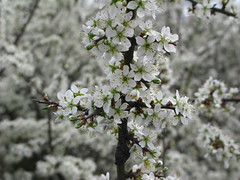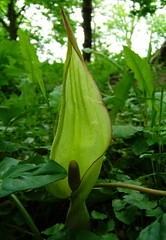In the hedgerows were the first signs of spring - Celendines with their beautiful lemon-yellow flowers, which open with the day. They have tiny heart-shaped leaves and in country areas, are harbingers of spring, arriving when the Primroses do. In previous years they have been earlier than this, but the cold snap in January and the snow earlier this month, has got spring back on a more even keel again.

There has been a dearth of Sloes on the Blackthorn in recent warm springs, which suggests they may have been encouraged to bloom too early and got caught by late frosts. There is an old saying that when the Blackthorn is in bloom, it is a Blackthorn Winter. This stems from there often being a warmer period at the end of winter - a false spring - and then a sudden cold snap returns. Here is a photo of the blossom, courtesy of Creative Commons.

The Sloe fruit is like a small black plum (it is a wild member of the Prunus - Plum - family) with a blue bloom on it. It is VERY sour, but makes wonderful jam and even better Sloe Gin! Its hedgerow relative the Bullace, is slightly larger and thought to be a cross between Sloe and domesticated plums.
 This 'witch's broom' is caused by a viral infection attacking the tree and causing a mass of twiggy growth.
This 'witch's broom' is caused by a viral infection attacking the tree and causing a mass of twiggy growth. The fruit of the Ivy. The leaves in the background are rather shapeless, unlike those three-cornered ones in the picture of the mossy bank below, which is how ivy normally grows. Likewise, holly leaves tend to lose their prickles when they are higher up in the tree and presumably because they are under less threat from predators!
The fruit of the Ivy. The leaves in the background are rather shapeless, unlike those three-cornered ones in the picture of the mossy bank below, which is how ivy normally grows. Likewise, holly leaves tend to lose their prickles when they are higher up in the tree and presumably because they are under less threat from predators! These are the leaves of the Ribwort Plantain which is very common in grassy places - banks, hedgerows and fields alike. When we were children we would 'fight' with the flower heads of these, which are brown cylinders on the end of the stalk, and by running your hand briskly up the stem you could catapult the head at your 'enemy'.
These are the leaves of the Ribwort Plantain which is very common in grassy places - banks, hedgerows and fields alike. When we were children we would 'fight' with the flower heads of these, which are brown cylinders on the end of the stalk, and by running your hand briskly up the stem you could catapult the head at your 'enemy'. Ivy leaves, top left, climbing over a mossy bank. Here in Wales there is no shortage of rainfall, and in consequence, plenty of mosses!
Ivy leaves, top left, climbing over a mossy bank. Here in Wales there is no shortage of rainfall, and in consequence, plenty of mosses! Here are the young leaves of Lords and Ladies, or Cuckoo Pint as they are also known. Their 'proper' name is the Wild Arum Lily. When in flower they look like this:
Here are the young leaves of Lords and Ladies, or Cuckoo Pint as they are also known. Their 'proper' name is the Wild Arum Lily. When in flower they look like this:
Here is Navelwort, so called becuse of the dimple in the middle of the leaf. They will grow on banks, treestumps and dead branches (as here), and on walls. My children used to pick the leaves and use them for doll's teaparties. Their leaves are prolific in winter, then they flower and put out a creamy stem of flowers (which I shall photograph when they bloom locally) and then they die back in the summer months.
 Now today (Friday) since clearing the shallow shelf of my wildlife pond, the first frogspawn has been laid. Photographs tomorrow.
Now today (Friday) since clearing the shallow shelf of my wildlife pond, the first frogspawn has been laid. Photographs tomorrow.
Nice idea...I like you have a huge love of the narural world and shall enjoy your new blog.
ReplyDeleteI just commented on C&Cream but not sure it went thru the screen went all odd?!doh!
ReplyDeleteI think this is a super super idea BB & will be looking forward to your posts so much.I remember this time last year you told me the name of celandines! & then shortly after wind anemones :o) I didnt know those either!
GTM x x x x
Oooh, Jennie, what beautiful pictures, and I think I'll be learning a lot here :)
ReplyDeleteKim x
Very interesting post BB - I love to see the Celandines out, they look so cheery when all around can still look quite drab. I never knew how the 'witches broom' effect was caused in trees - so I've learned something new already!
ReplyDeleteLooking forward to more posts!
Willow x
Great - I have visitors! And all "old" friends : ) I hope you will all learn something along the way, and that I will too, from your comments.
ReplyDelete